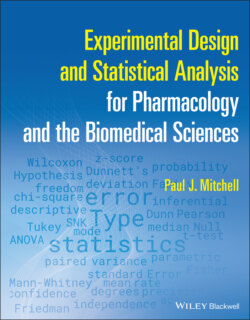Читать книгу Experimental Design and Statistical Analysis for Pharmacology and the Biomedical Sciences - Paul J. Mitchell - Страница 18
Statistical analysis: why are statistical tests required? The eye‐ball test!
ОглавлениеBut why do we need statistics? Surely life would be so much easier, less complicated, and with reduced levels of anxiety if we just did not bother. However, as scientists we have a duty to communicate the results of our studies to the wider world, and so we need to have confidence in the data generated by our studies. Consequently, we must provide evidence that supports the conclusions derived from our studies, and that support is provided by the statistical analysis of our data – but we should not rely purely upon our statistical analysis. The statistical data generated by our analysis is there to support our observations and not to replace what we can see with our own eyes. So, the first stage in analysing your data is to just look at it – but look at it with a critical eye. In Figure 1.1, it is quite clear that saline‐pre‐treated animals subsequently treated with mCPP exhibit far lower levels of locomotor activity than any of the other three treatment combinations – this simple observation is an example of the eye‐ball test (sometimes also known as the B.O. test – Bloody Obvious!). Importantly, the data also suggest that subjects pre‐treated with mesulergine subsequently fail to respond as expected to acute treatment with mCPP (i.e. they fail to show mCPP‐induced hypolocomotion); the main conclusion here, therefore, is that mesulergine blocks the behavioural effect of mCPP supporting the notion that because mesulergine is a 5‐HT2C receptor antagonist, then the hypolocomotor activity induced by mCPP is most likely mediated via agonist activity at 5‐HT2C receptors. The subsequent Inferential Statistical analysis simply supports this observation; this is important since the results of our statistical analysis should always be consistent with what we can see with our own eyes. If your statistical analysis contradicts what you can see, then there is something wrong in the presentation of your data, the statistical analysis used, or in the interpretation of the statistical results.
Another example of where the B.O. test alone provides confidence in our observations is the classical concentration–effect curve obtained with receptor agonists in isolated tissue experiments in vitro. Figure 1.3 summarises the effect of increasing concentrations of the α1 adrenoceptor agonist, phenylephrine, on the rat anococcygeus muscle.
Figure 1.3 Phenylephrine‐induced contraction of the rat anococcygeus muscle. Values show Mean ± S.E.M (N = 70) of the percentage maximal response (Y‐axis) plotted according to Log10 of the phenylephrine concentration (X‐axis). The mean EC50 value for phenylephrine (solid square) = 3.6 (2.8, 4.7) × 10−7 M. Mauchly's test indicated that the assumption of sphericity had been violated, χ 2 (90) = 1903.64, p < 0.001. Subsequent Greenhouse–Geisser corrected (ε = 0.156) Repeated Measures ANOVA revealed significant variation between the responses according to dose [F(2.027, 139.862) = 1618.36, p < 0.001]. Post hoc analysis (repeated Paired t‐test with Bonferroni correction) revealed significant difference between successive concentrations (p < 0.01) in all cases except between the highest two concentrations examined (p > 0.05). Data on file.
Clearly phenylephrine induces contractions of this smooth muscle, the magnitude of which is obviously related to drug concentration until a maximal response is achieved. Do we really need high‐powered statistical analysis to tell us what our eyes can clearly see? Probably not, but for completeness, I have included a suitable analysis in the figure legend.
However, life, and the data we generate, is not always so clear‐cut. The problem occurs when we are presented with data that are somewhat equivocal such that the eye‐ball test starts to fail. In such cases we then rely heavily on the results of our statistical approach – that is perfectly acceptable, as long as we stick to a few basic rules that ensure we use the correct statistical approach to analyse and understand our data. If we fail to do so, then we severely run the risk of making erroneous, unsubstantiated conclusions. As scientists we need to have a robust, objective approach to data analysis, so we can arrive at our conclusions with confidence. It is important to acknowledge that nothing is ever proven with statistical analysis in the scientific world. Statistical analysis is all about probability, and the most we can hope for is to demonstrate the likelihood that two or more groups are either similar or different.
